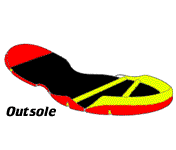Sports Shoes. Elementary considerations of sports shoes: part I




Different sports have different shoes. For example horse riding & ballet dance shoes are different that of running or football shoes. This following topic is written with reference to running & sports requiring similar shoes.
Athletic running sports shoes bring automatically an idea that they are soft on feet & absorb shock. However, Withnall R et al studying on army recruits reported similar rates of lower limb injuries were for all insoles (shock absorbing and non-shock absorbing) in a randomized controlled trial. The trial provides no support for a change in policy to the use of shock absorbing insoles for military recruits (4).
To clarify this ambiguity we found an opportunity to write an article is to assist in understanding athletic footwear. In addition, the various components of a typical athletic shoe are described, including the upper, the midsole/outsole. Hence let us review the parts of a sports shoe.
Parts of a sports shoe:
1. Upper
2. Insert
3. Midsole
4. Outsole
The upper: hold the midsole and outsole to the bottom of the foot. Upper provides upper as well as enhancing the flexibility, stability and support functions.
The insert: It influences the overall fit since it helps position the arch support. The need for, placement and inclusion of arch support systems varies greatly relative to gender, age, foot size, and arch type. It also is dependent on the sport and activity level of the athlete. An important modification of the insert is a shoe orthotics. This is a custom made insert that is designed to make up for structural problems in the foot. These structural problems might be genetic, or the result of chronic injuries.
The midsole: The midsole is the shoe's cushioning system. In early athletic shoes, especially in running shoes, midsoles didn't really exist. Not until an athlete with an interest in shoe design started thinking about running shoes and how they could be improved to reduce injuries and allow for more training did the invention of the midsole as we know it exist. We see today midsole "innovations" in every type of shoe from walking to basketball. The innovations range from improved foam midsoles to complicated air and fluid systems. Hence as a whole the midsole provides stability, flexibility, cushioning & durability.
The outsole: The main function of the outsole is to provide traction as well as to reduce wear on the midsole thereby increasing the overall durability of the shoe. Early outsole units were made of leather or rubber. They were later modified according to the athlete's need. For example, early running shoes used for track events could best be described as leather shoes with nails driven through them. Today, the outsoles for track shoes have plastic plates molded into them that allow a runner to change the spikes.Traction relative to specific movements in sports like basketball is provided by running vs. pivoting, type of surface as frictional needs differ, depending on the movement, in different areas of the outsole. An improved understanding of shoe-surface interactions remains a critical need to improve the design of shoe-surface combinations with the goal of meeting player needs while minimizing injury potential (3).
There are various models of athletic shoes & it is extremely difficult for the clinician to maintain a database of current shoe models and features. McPoil TG has stressed the importance of the clinician providing the athlete a list of footwear features and components based on their particular foot classification or problem, rather than attempting to recommend a specific model of athletic shoe. A detailed explanation of these features is provided to assist the practitioner in helping the athlete select the most appropriate shoe (1).
According to Reinschmidt C et al many investigations in the area of sport shoe research have shown that subject-specific responses can be expected. Different groups of athletes may require different types of shoes. The definition of these grouping characteristics and their design needs seem to be the most important challenge for the sport shoe researchers and manufacturers for the near future.
References:
1. McPoil TG; J Sci Med Sport. 2000 Sep;3(3):260-7.
2. http://www.scire.com/sds/Pages/design.html
3. Livesay GA; Am J Sports Med. 2006 Mar;34(3):415-22. Epub 2006 Jan 6
4. Withnall R et al ; J R Soc Med. 2006 Jan;99(1):32-7.


Comments
Post a Comment